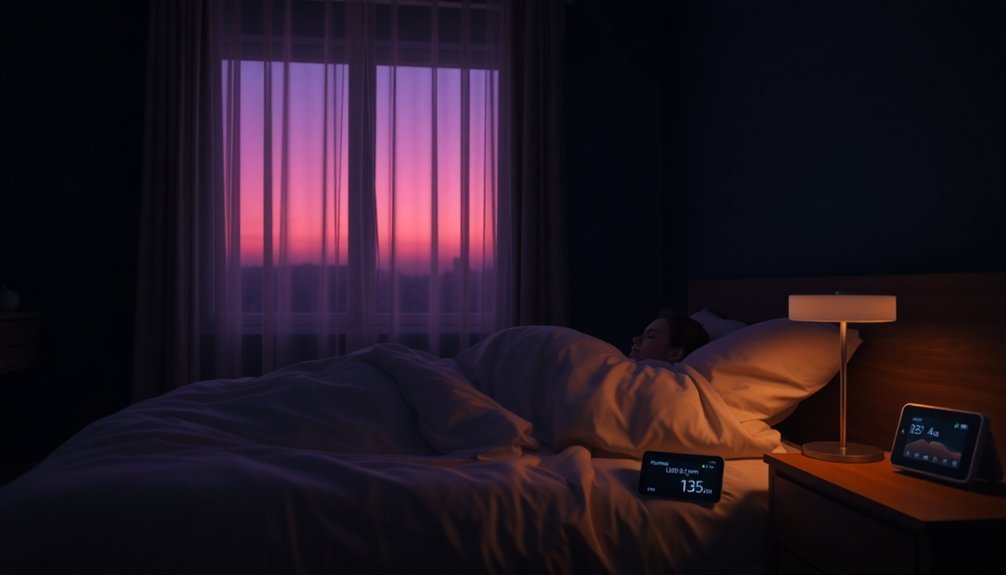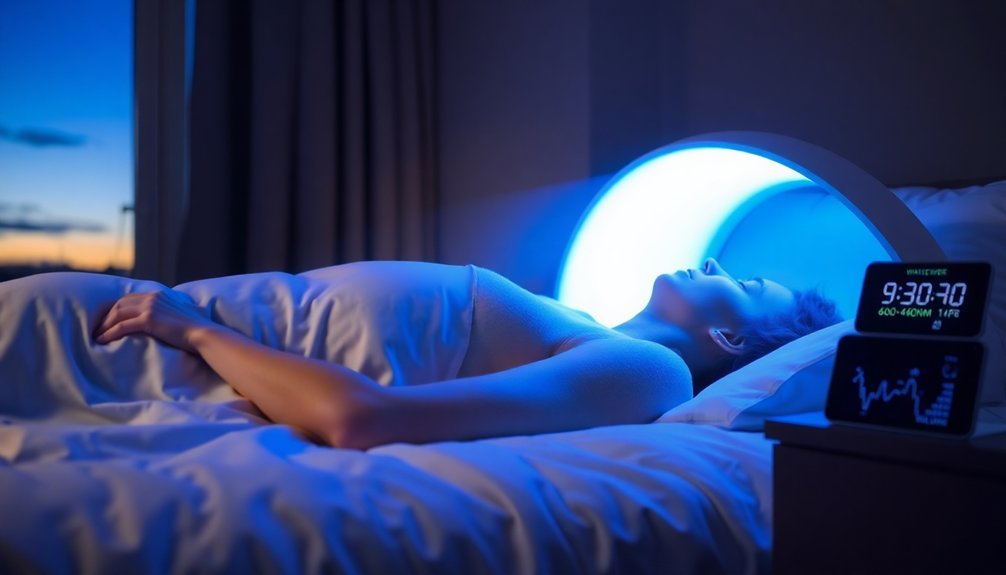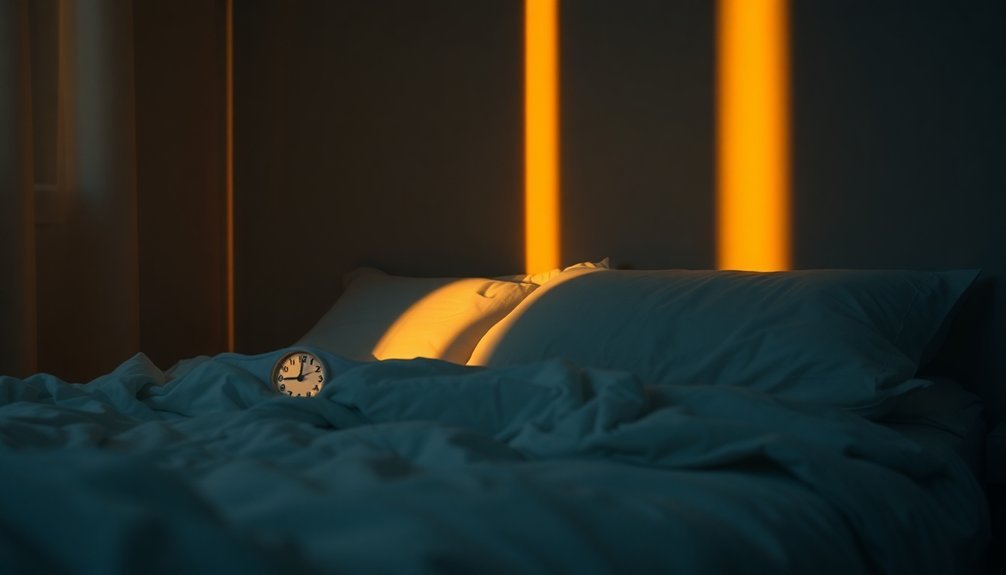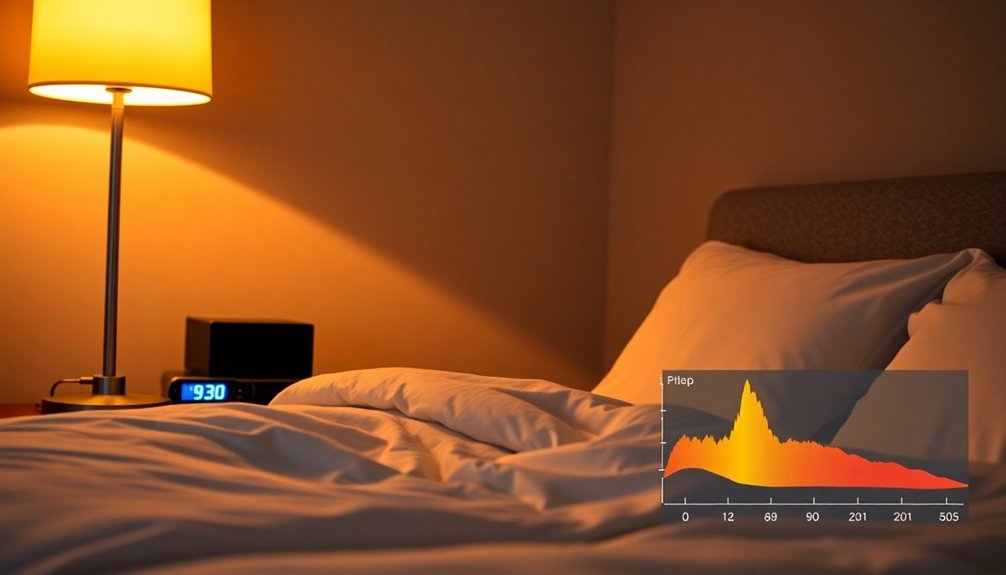To enhance your sleep, you'll want to minimize exposure to blue light (400-500nm) in the evening hours while maximizing exposure to red light (600-700nm). Start reducing blue light 2-3 hours before bedtime by using screen filters or switching to warm-toned lighting. For the best results, get 15-30 minutes of bright light exposure (over 1000 lux) in the morning and use red light therapy 1-2 hours before bed. You'll sleep better by maintaining consistent wake-sleep times and keeping your bedroom cool and dark. Understanding how different wavelengths affect your circadian rhythm can transform your sleep quality.
Understanding Light Wavelengths For Sleep

Three key wavelengths of light dramatically influence your sleep quality and circadian rhythm. Blue light, around 460-480nm, has the strongest impact on your circadian timing, as it directly affects melanopsin – a photoreceptor that controls melatonin production. When you're exposed to this wavelength, particularly at night, your body suppresses melatonin, increasing alertness and disrupting your natural sleep cycle.
Warm wavelengths, including red and orange light, don't interfere with your sleep patterns as substantially. In fact, red light can actually enhance melatonin production when used appropriately, helping you prepare for restful sleep. The key is controlling the brightness and timing of exposure. Research shows that high light intensities of at least 5000 lux are needed for effective circadian entrainment.
Your body's biological clock relies on these light signals to maintain proper CLOCK gene expression in the suprachiasmatic nucleus (SCN). When you're exposed to artificial light, especially blue wavelengths from digital devices in the evening, you're fundamentally telling your body to stay awake.
This misalignment can lead to serious health consequences, affecting everything from your metabolism to cardiovascular function. Understanding these wavelengths' effects helps you make informed decisions about your light exposure throughout the day.
Sleep Cycles And Duration Basics
Your sleep consists of four to six 90-minute cycles each night, with each cycle moving through light sleep, deep sleep, and REM sleep phases.
You'll need different amounts of sleep as you age, ranging from 14-17 hours for newborns to 7-9 hours for adults.
The composition of a sleep cycle changes throughout the night, with later cycles lasting up to 120 minutes.
Following your body's natural sleep-wake rhythm will help you align with your circadian clock, making it easier to fall asleep at night and wake up refreshed in the morning.
Understanding Sleep Cycle Phases
During a typical night's sleep, you'll cycle through distinct sleep phases that last between 90 to 120 minutes each. You'll experience four to six complete cycles throughout the night, with each cycle following a specific progression through three non-REM stages and one REM stage.
Your sleep begins with N1, the lightest stage lasting just 1-5 minutes. You'll then move into N2, which makes up about 45% of your total sleep time and features unique brain patterns called sleep spindles and K complexes. Getting quality rest during this stage is crucial, as certain medications can disrupt these natural patterns.
N3 follows as your deepest sleep phase, comprising 25% of your night and playing a vital role in physical restoration and immune system function.
After cycling through these NREM stages, you'll enter REM sleep, where you'll experience vivid dreams and temporary muscle paralysis. Your first REM period is brief, but these periods lengthen to 30-60 minutes in later cycles.
You'll spend more time in deep NREM sleep during the first half of the night, while REM sleep becomes more prominent in the later hours. This natural progression guarantees both physical and mental restoration throughout your night's rest.
Recommended Hours By Age
Building on our understanding of sleep cycles, let's now explore how much sleep different age groups need for ideal health. Your age considerably influences how much sleep you'll need to function effectively and maintain good health. Newborns require the most sleep, needing 14-17 hours daily, while this gradually decreases as you age into adulthood.
Quality sleep requires a quiet environment for optimal rest and rejuvenation.
Here's what you need to know about age-specific sleep requirements:
- Infants (4-12 months) should get 12-16 hours, including naps, to support their rapid development.
- Toddlers and preschoolers need 11-14 hours as their brains continue forming essential connections.
- School-age children require 9-11 hours to maintain focus and support learning.
- Teenagers should aim for 8-10 hours, though many don't get enough.
- Adults (18-64) consistently need 7-9 hours for effective functioning.
You'll want to establish consistent bedtimes based on these recommendations. For school-age children, aim for 8:00-9:30 PM, while teenagers should target 9:00-10:30 PM.
Remember that these are general guidelines, and your individual needs might vary slightly. If you're consistently sleeping outside these ranges, you should consult a healthcare provider.
Natural Sleep Pattern Timing
Understanding sleep cycles reveals a fascinating pattern that affects how we rest each night. Your body typically moves through 4-6 complete sleep cycles, with each cycle lasting about 90-110 minutes. During these cycles, you'll progress through specific stages from light sleep (N1) to deeper sleep (N2 and N3), followed by REM sleep. Sleep spindles and K-complexes appear during N2 sleep as your brain begins consolidating memories.
Your natural sleep patterns align with your body's internal 24-hour clock, known as the circadian rhythm. You'll feel strongest sleep urges between midnight and dawn, with a lesser sleepiness wave in mid-afternoon.
That's why you might find yourself naturally dozing off between 2-4 a.m. or during the afternoon between 2-3 p.m.
As you sleep, your body distributes sleep stages uniquely throughout the night. You'll experience most of your deep sleep (N3) during the first half of the night, while REM periods become longer in later cycles. Your first REM episode might last just a few minutes, but subsequent ones will increase in duration.
Throughout the night, you'll spend about 75% of your time in NREM sleep, with most of that occurring in stage N2.
Effective Light Therapy Timing

The timing of light therapy plays a crucial role in its effectiveness for treating both winter depression and sleep disorders. You'll need to align your treatment with your natural circadian rhythm for the best results. Research shows that young women are particularly affected by seasonal depression requiring proper light therapy timing.
For winter depression, aim for light exposure 8.5 hours after your melatonin onset, which you can estimate by identifying your sleep midpoint.
- Morning bright light therapy (1,000+ lux) works best 2.5 hours after your sleep midpoint
- Evening red light therapy should be used 1-2 hours before bedtime for 15-30 minutes
- Your individual sleep patterns determine the ideal timing window
- Consistent timing matters more than occasional variations
- Wrong timing can disrupt your circadian rhythm instead of helping it
For sleep improvement, you'll want to time your light exposure based on your specific sleep patterns. If you're a short sleeper, use light therapy at your normal wake time. For longer sleepers, you might need to wake up earlier for treatment.
Remember to avoid evening bright light exposure, as it can push your internal clock backward. Instead, opt for red light therapy in the evening to promote relaxation and better sleep quality.
Choosing Your Light Therapy Device
Selecting your ideal light therapy device requires careful consideration of several key factors to guarantee the best sleep benefits. Look for devices that emit wavelengths between 600 to 650 nanometers, as this range has proven most effective for improving sleep quality. Red light therapy at 630 nanometers provides optimal wavelength accuracy for sleep enhancement.
When choosing your device, consider its size and portability based on your needs. Handheld models like the LumaGlow offer convenience for travel, while larger panels like the R1 and R3 provide coverage for broader body areas.
You'll want to confirm your device includes customization options, such as adjustable intensity levels and treatment modes, to match your specific requirements.
Safety should be your top priority. Choose devices that are 100% safe and natural, and always follow the manufacturer's guidelines for proper usage. You'll need to maintain a safe distance from the device and avoid direct eye exposure during sessions.
For the best results, plan for 20-40 minute sessions and establish a consistent routine.
Consider combining your light therapy with relaxation techniques and tracking your progress through a sleep journal. This approach will help you maximize the benefits and adjust your routine as needed.
Wavelength Impact On Sleep Quality

Your sleep quality suffers substantially from exposure to short-wavelength blue light, which disrupts your body's natural melatonin production and circadian rhythms.
You'll find relief by using wavelength filtering solutions, such as screen filters and night mode settings on your devices, which reduce harmful blue light exposure before bedtime.
Following natural sleep patterns means aligning your light exposure with the sun's cycle, limiting artificial light in the evening, and creating a dark environment for sleep. Even 5-10 lux levels of light can affect your sleep cycle when your eyes are closed.
Blue Light Sleep Effects
Modern screens and devices emit powerful blue light that disrupts your natural sleep cycle, making it harder to get quality rest. When you're exposed to blue light in the evening, your brain suppresses melatonin production, the hormone responsible for regulating sleep. This suppression can shift your circadian rhythm and leave you tossing and turning when you should be sleeping soundly.
While blue light exposure during daylight hours can boost your alertness and cognitive performance, nighttime exposure can seriously impact your sleep health.
You'll notice these effects most prominently through:
- Difficulty falling asleep, even when you feel tired
- Reduced overall sleep duration and quality
- Disrupted sleep-wake patterns that affect your next day
- Increased risk of metabolic disorders with chronic exposure
- Mental health impacts from prolonged sleep disruption
You can protect your sleep by implementing blue light reduction strategies. Start by avoiding screens 2-3 hours before bedtime, using night shift modes on devices, and considering blue light blocking glasses. For evening lighting, opt for dim red lights instead of bright white or blue ones. Getting bright light exposure during the day will also help maintain your natural circadian rhythm.
Wavelength Filtering Solutions
While blue light itself affects sleep, understanding specific wavelengths helps explain why certain solutions work better than others. The most disruptive wavelengths fall between 460-480nm, directly impacting your melatonin production and signaling your brain to stay awake.
To protect your sleep quality, you'll need to effectively filter these specific wavelengths.
You've got several practical options to reduce exposure to these wavelengths. Night mode settings on your devices and blue light filtering glasses can effectively block wavelengths below 480nm. When choosing filtering solutions, opt for sharp cut-off filters rather than gradual ones, as they're more effective at preventing sleep disruptions.
You can also combine these with brightness adjustments on your devices for enhanced protection.
Real-world applications have proven these solutions work. Whether you're a shift worker or simply using devices in the evening, consistent use of wavelength filtering can substantially improve your sleep quality.
For the best results, pair evening filtering with morning light exposure. This combination helps maintain your natural sleep-wake cycle while protecting you from disruptive wavelengths when they matter most.
Natural Sleep Patterns
Through millions of years of evolution, natural sleep patterns have been fundamentally tied to light wavelengths and their impact on our biological systems. Your body's natural rhythm responds most strongly to short-wavelength light, particularly in the blue spectrum around 460-490 nm. This wavelength directly affects your melatonin production, which governs your sleep-wake cycle.
Your circadian rhythm isn't just about feeling sleepy at night – it's a complex system that responds to light exposure throughout the day.
You'll notice these key impacts on your natural sleep patterns:
- Morning light exposure advances your sleep phase, helping you wake up earlier
- Evening blue light delays your sleep onset by suppressing melatonin
- Even low light levels (5-10 lux) can affect your sleep while your eyes are closed
- Your body responds more to wavelength than color, with violet light (424 nm) having the strongest effect
- Age reduces melatonin production but doesn't impair your ability to respond to light cues
Understanding these patterns helps you work with your body's natural rhythms. By timing your light exposure properly, you can maintain healthy sleep patterns that align with your circadian rhythm and sleep-wake homeostasis.
Building Your Sleep Optimization Plan
Creating an effective sleep optimization plan begins with understanding your unique sleep patterns and requirements. You'll need to establish consistent wake and sleep times that align with your circadian rhythm while ensuring you're getting the appropriate duration for your age group.
Start by setting up your sleep environment for success. Keep your bedroom cool and dark, limit exposure to artificial light in the evening, and minimize digital device use before bed.
You'll want to avoid caffeine, heavy meals, and alcohol near bedtime, as these can substantially impact your sleep quality.
Monitor your progress using sleep trackers or logs to identify patterns and areas for improvement. Don't forget to incorporate stress management techniques like NSDR or self-hypnosis if you're finding it difficult to unwind.
Regular physical exercise can improve sleep quality, but schedule it earlier in the day.
Use the Pittsburgh Sleep Quality Index to assess your sleep quality objectively, and make adjustments based on your findings. Remember to expose yourself to morning sunlight to regulate your circadian rhythm, and consider sleep-promoting supplements like melatonin or magnesium threonate if needed.
Stay flexible with your plan, adapting it as your sleep patterns and lifestyle change.
Frequently Asked Questions
Can Certain Medications Affect How Light Therapy Impacts My Sleep Patterns?
Yes, your medications can substantially affect light therapy's impact on sleep. Antidepressants, beta-blockers, and other drugs may alter your body's response to light therapy by disrupting natural circadian rhythms and melatonin production.
How Does Altitude or Geographical Location Influence Optimal Light Therapy Timing?
You'll need to adjust your light therapy timing based on your location: higher altitudes require shorter exposure times, while your position in a time zone affects when you should start treatment for the best results.
Are There Specific Genetic Factors That Affect Individual Responses to Wavelengths?
Yes, your genes in ARL14EP and circadian clock genes like Per1 and Per2 can affect how you respond to different light wavelengths, influencing your sensitivity to blue light and overall sleep-wake timing.
Does Wearing Contact Lenses or Having Eye Conditions Impact Light Therapy Effectiveness?
Yes, contact lenses can affect light therapy's effectiveness by altering light exposure, though specialized therapeutic lenses may enhance treatment. If you have eye conditions, you'll need careful monitoring as they can increase light sensitivity risks.
How Do Seasonal Changes Affect Recommended Light Exposure Durations for Sleep?
You'll need longer light exposure during fall/winter months (30-60 minutes) compared to spring/summer (15-30 minutes). Adjust your morning light therapy timing based on reduced daylight hours and seasonal changes.
In Summary
You've now got the key tools to enhance your sleep using light therapy. Remember to time your light exposure carefully, choose devices with the right wavelengths, and stick to your personalized sleep plan. When you combine proper duration with the best wavelengths, you'll notice improved sleep quality and more consistent rest patterns. Start implementing these changes tonight, and you'll be on your way to better sleep.





Leave a Reply